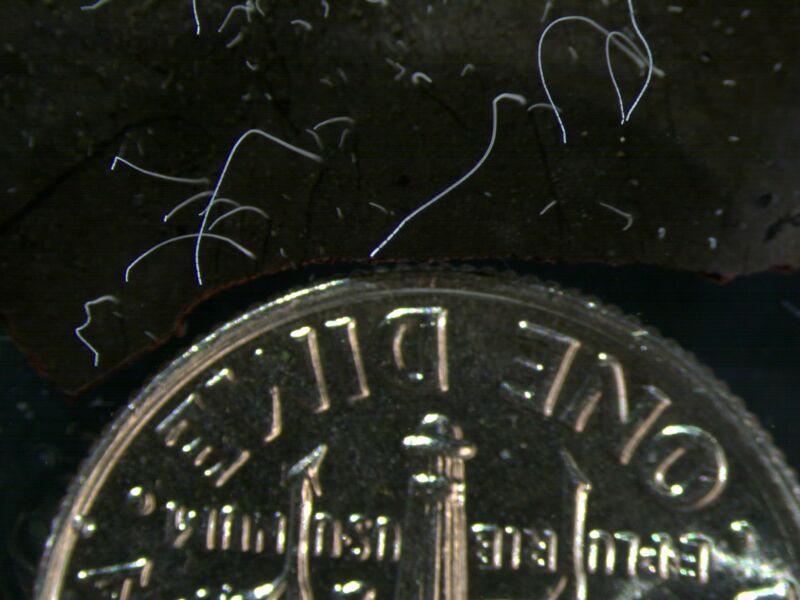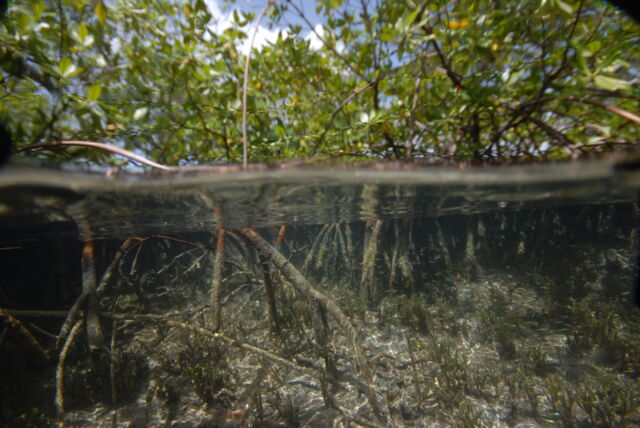
Clinging to sunken debris in shallow, marine mangrove forests in the French Caribbean, tiny thread-like organisms—perfectly visible to the naked eye—have earned the title of the largest bacteria ever known.
Measuring around a centimeter long, they are roughly the size and shape of a human eyelash, batting away the competition at 5,000 times the size of garden-variety bacteria and 50 times the size of bacteria previously considered giant. In human terms, this is akin to coming across a person as tall as Mount Everest.

Olivier Gros, a biologist at the University of the Antilles, discovered the prokaryotes in 2009, noticing them gently swaying in the sulfur-rich waters among the mangroves in the Guadeloupe archipelago. The bacteria clung to the leaves, branches, oyster shells, and bottles that sunk into the tropical swamp, Gros said in a press briefing.
He and colleagues first thought they might be complex eukaryotic organisms or perhaps a string of linked organisms. But years of genetic and molecular research revealed that each string is, in fact, one towering bacterial cell, genetically related to other sulfur-oxidizing bacteria. “Of course, this was quite a surprise,” Jean-Marie Volland, a microbiologist at the Joint Genome Institute in Berkeley, California, said in the briefing.
This week, Gros and colleagues published an article in Science laying out everything they’ve learned about the new, enormous bacteria, which they’ve dubbed Candidatus (Ca.) Thiomargarita magnifica.
Their findings expand our understanding of microbial diversity in ways microbiologists didn’t think possible. Scientists previously hypothesized that the size of bacteria would be limited by several factors, including a lack of intracellular transport systems, reliance on inefficient chemical diffusion, and a surface-to-volume ratio needed to satisfy energy needs. Yet, the volume of a single Ca. T. magnifica cell is at least two orders of magnitude larger than the predicted maximum that a bacterium can theoretically achieve, Volland said.
-
Filaments of Ca. Thiomargarita magnifica.Jean-Marie Volland
-
Filaments of Ca. Thiomargarita magnifica.Jean-Marie Volland
Volland, Gros, and colleagues are still learning how—and why exactly—Ca. T. magnifica manages its massive size. But, so far, it’s clear that Ca. T. magnifica oxidizes hydrogen sulfide from its sulfur-rich environment and reduces nitrate. About 75 percent of its cell volume is a sac of stored nitrate. The sac crushes up against the cell’s envelope, limiting the depth that nutrients and other molecules need to diffuse.
While bacteria tend to have free-floating DNA, Ca. T. magnifica appears to have more than half a million copies of its genome bundled up into numerous membrane-bound compartments that the researchers named pepins, after small seeds in fruit. The distribution of pepins throughout the bacteria’s outer edges could allow for localized protein production, eliminating the need to transport proteins long distances.
The next step to studying these gargantuan bacteria is for scientists to figure out how to culture them in labs. For now, the researchers have collected new specimens from the mangrove forests every time they run out. But, this has been tricky since they appear to have a mysterious life cycle or seasonality. For the last two months, Gros has not been able to find any. “I don’t know where they are,” he said.
https://arstechnica.com/?p=1862857

